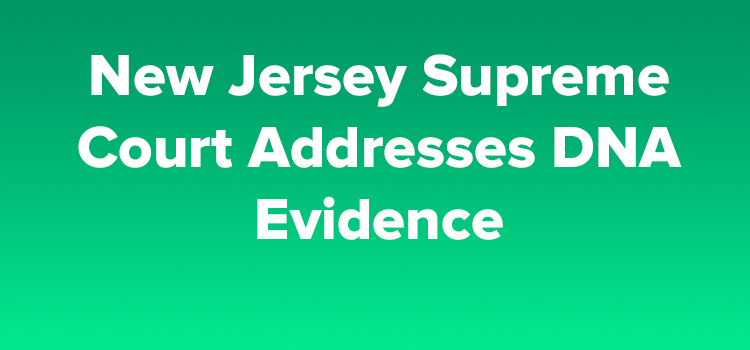DNA evidence increasingly plays a role in the criminal justice system. In its recent decision in State v. Rafael Camey (A-73-17/080574) (Decided August 1, 2019),the New Jersey Supreme Court clarified when law enforcement may obtain a suspect’s DNA after its initial search is deemed invalid.

Facts of State v. Rafael Camey
On September 30, 2013, the Passaic Police Department received a 9-1-1 report of a brutally beaten body of a woman, later identified as “Katie,” in a wooded area near a riverbank behind a ShopRite store. Defendant Rafael Camey was ultimately charged with her murder.
Sergeant Bordamonte, the lead detective in the matter, was familiar with “Tina,” a prostitute, who placed the 9-1-1 call. Tina stated that Katie was “the new girl on the block” and that she saw Katie with a person she described as a “violent Mexican male” on the night before Katie’s death.
Over the next weeks, the police interviewed and took, with consent, buccal swabs from numerous individuals who were in the vicinity of where Katie’s body was found. On October 20, 2013, Tina called police to report that she saw the violent male. After Tina made an on-scene identification of defendant, officers detained Camey. A detective advised Camey of his Miranda rights and interviewed him in Spanish, his native language, but presented him with a consent form for a buccal swab printed in English. After Camey signed the untranslated form, another detective took a buccal swab from him and released him. On June 25, 2014, the State Police notified Bordamonte that DNA found on Katie’s body matched the defendant’s DNA profile. That day, Camey was placed under arrest and charged with felony murder, murder, and aggravated sexual assault.
During pre-trial applications, the trial court determined that the consent obtained from Camey was invalid and ordered suppression of the DNA test results from that swab, holding that the swab was the product of an illegal detention, the consent form presented to the defendant was written in English and never translated for him into his native Spanish, and Camey was never informed of his right to refuse or that the DNA would be sent to a police lab for analysis in a criminal investigation.
Thereafter, the trial court also rejected the State’s further argument that the swab’s results were admissible under the inevitable discovery exception to the exclusionary rule as set forth in New Jersey in State v. Sugar, 100 N.J. 214 (1985) (Sugar II). The court determined that the State failed to show that proper, normal and specific investigative procedures would have been pursued. It also rejected the State’s argument that it would have inevitably obtained the defendant’s DNA because police are statutorily required to take a DNA sample from persons arrested for certain enumerated violent crimes including sexual assault (with which Camey was charged here). Because Camey was arrested primarily based on the illegally obtained DNA sample, the court would not allow the State to rely on an arrest based on those DNA results to justify the taking of another swab. The Appellate Division affirmed the suppression of the results from that swab.
The State subsequently sought to compel Camey to provide a new buccal swab under Rule 3:5A. However, the trial court denied the motion. It concluded that the application must also be evaluated under inevitable discovery and held that the doctrine’s application already had been rejected by the court. The Appellate Division affirmed.
New Jersey Supreme Court’s Decision in State v. Rafael Camey
The New Jersey Supreme Court affirmed the suppression of DNA evidence from the first buccal swab. “We hold that the trial court’s thorough and detailed reasons for denying admission of this evidence, under either of the State’s two inevitable discovery arguments, are clearly sustainable on appeal,” the court wrote.
The court further held that the State’s application for a second buccal swab requires a remand. “We vacate the Appellate Division’s affirmance of the denial of the State’s application to take a new buccal swab from defendant and remand for further proceedings consistent with this opinion and the new test set forth herein,” the court wrote. It went on to describe its new test as follows:
First, the State must demonstrate that probable cause exists to conduct the new search. The court should look at the showing advanced by the State to demonstrate probable cause. The evidence may involve the same evidence that existed at the time of the illegal search. We do not exclude its consideration. We permit but do not require new evidence. Thus, Tina’s statements and her identification of defendant are not off-limits. Second, the court should determine whether the State’s showing of probable cause is untainted by the results of the prior search. Here, we mean that the probable cause must be independent of the information obtained through the results from the prior swab. Third, to deter wrongdoing by the police, we track the third prong of the independent source doctrine and require the State to show by clear and convincing evidence that the initial impermissible search was not the result of flagrant police misconduct. Finally, because of the privacy interest involved, we consider the degree of the intrusion posed by the State’s second search. A buccal swab is minimally intrusive
According to the court, its approach “protects a suspect’s constitutional rights and recognizes the legitimate public interest in a fair assessment of whether a second buccal swab sample should be allowed.” The New Jersey Supreme Court remanded the case to allow the State to demonstrate whether it can meet its new standard.
